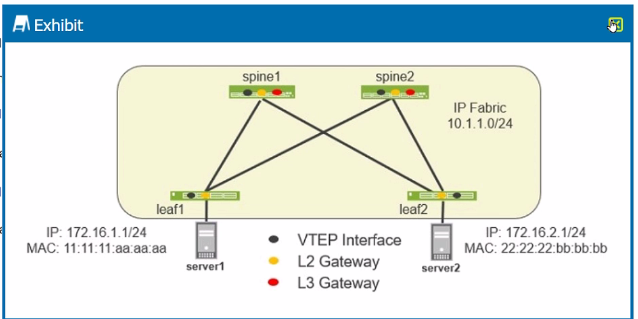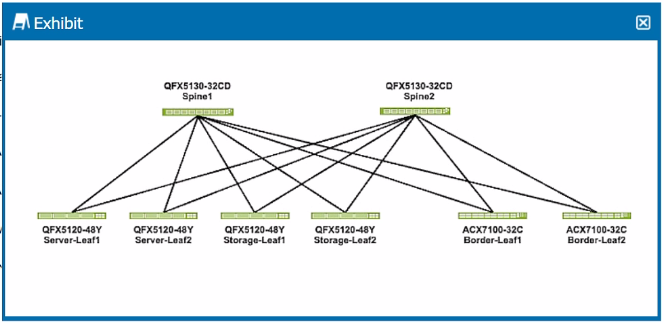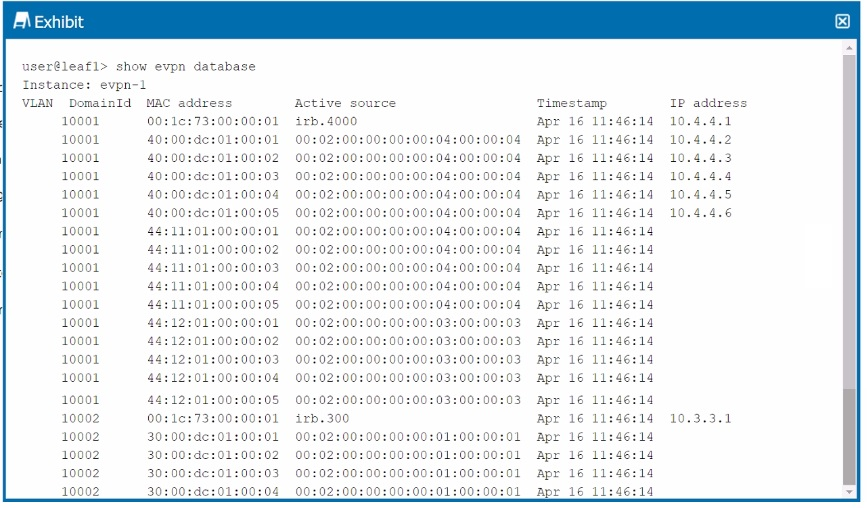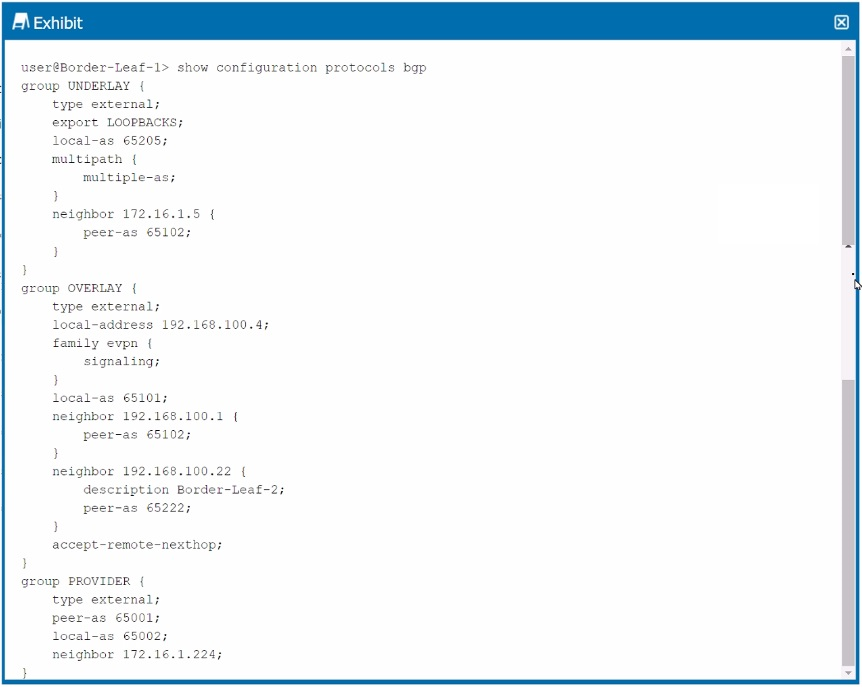Juniper JN0-683 Data Center Professional Exam Practice Test
Exhibit.

You have implemented an EVPN-VXLAN data center. Device served must be able to communicate with device server2.
Referring to the exhibit, which two statements are correct? (Choose two.)
Answer : C, D
Understanding the Exhibit Setup:
The network diagram shows an EVPN-VXLAN setup, a common design for modern data centers enabling Layer 2 and Layer 3 services over an IP fabric.
Leaf1 and Leaf2 are the leaf switches connected to Server1 and Server2, respectively, with each server in a different subnet (172.16.1.0/24 and 172.16.2.0/24).
Spine1 and Spine2 are part of the IP fabric, interconnecting the leaf switches.
EVPN-VXLAN Basics:
EVPN (Ethernet VPN) provides Layer 2 and Layer 3 VPN services using MP-BGP.
VXLAN (Virtual Extensible LAN) encapsulates Layer 2 frames into Layer 3 packets for transmission across an IP network.
VTEP (VXLAN Tunnel Endpoint) interfaces on leaf devices handle VXLAN encapsulation and decapsulation.
Integrated Routing and Bridging (IRB):
IRB interfaces are required on leaf1 and leaf2 (where the endpoints are directly connected) to route between different subnets (in this case, between 172.16.1.0/24 and 172.16.2.0/24).
The IRB interfaces provide the necessary L3 gateway functions for inter-subnet communication.
Traffic Flow Analysis:
Traffic from Server1 (172.16.1.1) destined for Server2 (172.16.2.1) must traverse from leaf1 to leaf2.
The traffic will be VXLAN encapsulated on leaf1, sent over the IP fabric, and decapsulated on leaf2.
Since the communication is between different subnets, the IRB interfaces on leaf1 and leaf2 are crucial for routing the traffic correctly.
Correct Statements:
C . An IRB Interface must be configured on leaf1 and leaf2: This is necessary to perform the inter-subnet routing for traffic between Server1 and Server2.
D . Traffic from server1 to server2 will transit the VXLAN tunnel between leaf1 and leaf2: This describes the correct VXLAN operation where the traffic is encapsulated by leaf1 and decapsulated by leaf2.
Data Center Reference:
In EVPN-VXLAN architectures, the leaf switches often handle both Layer 2 switching and Layer 3 routing via IRB interfaces. This allows for efficient routing within the data center fabric without the need to involve the spine switches for every routing decision.
The described traffic flow aligns with standard EVPN-VXLAN designs, where direct VXLAN tunnels between leaf switches enable seamless and scalable communication across a data center network.
Exhibit.

You are deploying a VXLAN overlay with EVPN as the control plane in an ERB architecture.
Referring to the exhibit, which three statements are correct about where the VXLAN gateways will be placed? (Choose three.)
Answer : B, C, E
Understanding ERB Architecture:
ERB (Edge Routed Bridging) architecture is a network design where the routing occurs at the edge (leaf devices) rather than in the spine devices. In a VXLAN overlay network with EVPN as the control plane, leaf devices typically act as both Layer 2 (L2) and Layer 3 (L3) VXLAN gateways.
Placement of VXLAN Gateways:
Option B: All leaf devices will have L2 VXLAN gateways to handle the bridging of VLAN traffic into VXLAN tunnels.
Option C: All leaf devices will also have L3 VXLAN gateways to route traffic between different VXLAN segments (VNIs) and external networks.
Option E: Spine devices in an ERB architecture generally do not function as VXLAN gateways. They primarily focus on forwarding traffic between leaf nodes and do not handle VXLAN encapsulation/decapsulation.
Conclusion:
Option B: Correct---All leaf devices will have L2 VXLAN gateways.
Option C: Correct---All leaf devices will have L3 VXLAN gateways.
Option E: Correct---Spine devices will not act as VXLAN gateways
You are deploying an EVPN-VXLAN overlay. You must ensure that Layer 3 routing happens on the spine devices. In this scenario, which deployment architecture should you use?
Answer : B
Understanding EVPN-VXLAN Architectures:
EVPN-VXLAN overlays allow for scalable Layer 2 and Layer 3 services in modern data centers.
CRB (Centralized Routing and Bridging): In this architecture, the Layer 3 routing is centralized on spine devices, while the leaf devices focus on Layer 2 switching and VXLAN tunneling. This setup is optimal when the goal is to centralize routing for ease of management and to avoid complex routing at the leaf level.
ERB (Edge Routing and Bridging): This architecture places routing functions on the leaf devices, making it a distributed model where each leaf handles routing for its connected hosts.
Architecture Choice for Spine Routing:
Given the requirement to ensure Layer 3 routing happens on the spine devices, the CRB (Centralized Routing and Bridging) architecture is the correct choice. This configuration offloads routing tasks to the spine, centralizing control and potentially simplifying the overall design.
With CRB, the spine devices perform all routing between VXLAN segments. Leaf switches handle local switching and VXLAN encapsulation, but routing decisions are centralized at the spine level.
This model is particularly advantageous in scenarios where centralized management and routing control are desired, reducing the complexity and configuration burden on the leaf switches.
Data Center Reference:
The CRB architecture is commonly used in data centers where centralized control and simplified management are key design considerations. It allows the spines to act as the primary routing engines, ensuring that routing is handled in a consistent and scalable manner across the fabric.
What are two ways in which an EVPN-signaled VXLAN is different from a multicast-signaled VXLAN? (Choose two.)
Answer : B, C
Multicast-Signaled VXLAN:
In traditional multicast-signaled VXLAN, VTEPs (VXLAN Tunnel Endpoints) use multicast to flood and learn about remote VTEPs. This method relies on multicast in the underlay network to distribute BUM (Broadcast, Unknown unicast, and Multicast) traffic.
This approach can be resource-intensive due to the need for multicast group management and increased network traffic, especially in large deployments.
EVPN-Signaled VXLAN:
EVPN-signaled VXLAN uses BGP (Border Gateway Protocol) to signal the presence of VTEPs and distribute MAC address information. BGP is used for VTEP autodiscovery and the distribution of endpoint information.
This method is more efficient because it reduces the reliance on multicast, instead using BGP control-plane signaling to handle VTEP discovery and MAC learning, which reduces the overhead on the network and improves scalability.
Correct Statements:
B . An EVPN-signaled VXLAN can perform autodiscovery of VTEPs using BGP: This is correct because EVPN uses BGP for VTEP autodiscovery, making it more efficient and scalable compared to multicast-based methods.
C . An EVPN-signaled VXLAN is less resource-intensive: This is correct because it eliminates the need for multicast flooding in the underlay, instead using BGP for signaling, which is less demanding on network resources.
Incorrect Statements:
A . An EVPN-signaled VXLAN can perform autodiscovery of VTEPs using IS-IS: This is incorrect because EVPN relies on BGP, not IS-IS, for VTEP discovery and signaling.
D . An EVPN-signaled VXLAN features slower and more complete convergence: This is incorrect; EVPN with BGP typically provides faster convergence due to its use of a control plane rather than relying on data plane learning.
Data Center Reference:
EVPN-VXLAN is widely adopted in modern data center designs due to its scalability, efficiency, and reduced resource consumption compared to multicast-based VXLAN solutions. It leverages the strengths of BGP for control-plane-driven operations, resulting in more efficient and scalable networks.
You are implementing VXLAN broadcast domains in your data center environment. Which two statements are correct in this scenario? (Choose two.)
Answer : A, C
VXLAN Overview:
VXLAN (Virtual Extensible LAN) is a network virtualization technology that encapsulates Layer 2 Ethernet frames into Layer 3 UDP packets for transmission over an IP network. It allows the creation of Layer 2 overlay networks across a Layer 3 infrastructure.
Understanding VXLAN Components:
VTEP (VXLAN Tunnel Endpoint): A VTEP is responsible for encapsulating and decapsulating Ethernet frames into and from VXLAN packets.
VNI (VXLAN Network Identifier): A 24-bit identifier used to distinguish different VXLAN segments, allowing for up to 16 million unique segments.
Correct Statements:
C . Layer 2 frames are encapsulated by the source VTEP: This is correct. In a VXLAN deployment, the source VTEP encapsulates the original Layer 2 Ethernet frame into a VXLAN packet before transmitting it over the IP network to the destination VTEP, which then decapsulates it.
A . A VXLAN packet does not contain a VLAN ID: This is correct. The VXLAN header does not carry the original VLAN ID; instead, it uses the VNI to identify the network segment. The VLAN ID is local to the switch and does not traverse the VXLAN tunnel.
Incorrect Statements:
B . The VNI must match the VLAN tag to ensure that the remote VTEP can decapsulate VXLAN packets: This is incorrect. The VNI is independent of the VLAN tag, and the VLAN ID does not need to match the VNI. The VNI is what the remote VTEP uses to identify the correct VXLAN segment.
D . The VNI is a 16-bit value and can range from 0 through 16,777,215: This is incorrect because the VNI is a 24-bit value, allowing for a range of 0 to 16,777,215.
Data Center Reference:
VXLAN technology is critical for modern data centers as it enables scalability and efficient segmentation without the constraints of traditional VLAN limits.
Exhibit.

The exhibit shows the truncated output of the show evpn database command.
Given this output, which two statements are correct about the host with MAC address 40:00:dc:01:00:04? (Choose two.)
Answer : A, D
Understanding the Output:
The show evpn database command output shows the MAC address, VLAN, active source, timestamp, and IP address associated with various hosts in the EVPN instance.
Analysis of the MAC Address:
Option A: The MAC address 40:00:dc:01:00:04 is associated with the IP address 10.4.4.5, as indicated by the output in the IP address column. This confirms that this host has been assigned the IP 10.4.4.5.
Option D: The active source for the MAC address 40:00:dc:01:00:04 is listed as 00:02:00:00:00:04:00:04:00:00:04:00:04, which indicates that the host is connected via an ESI (Ethernet Segment Identifier) LAG (Link Aggregation Group). This setup is typically used in multi-homing scenarios to provide redundancy and load balancing across multiple physical links.
Conclusion:
Option A: Correct---The host with MAC 40:00:dc:01:00:04 is assigned IP 10.4.4.5.
Option D: Correct---The host is originating from an ESI LAG, as indicated by the active source value.
Exhibit.

You are troubleshooting a DCI connection to another data center The BGP session to the provider is established, but the session to Border-Leaf-2 is not established. Referring to the exhibit, which configuration change should be made to solve the problem?
Answer : D, D
Understanding the Configuration:
The exhibit shows a BGP configuration on a Border-Leaf device. The BGP group UNDERLAY is used for the underlay network, OVERLAY for EVPN signaling, and PROVIDER for connecting to the provider network.
The OVERLAY group has the accept-remote-nexthop statement, which is designed to accept the next-hop address learned from the remote peer as is, without modifying it.
Problem Identification:
The BGP session to Border-Leaf-2 is not established. A common issue in EVPN-VXLAN environments is related to next-hop reachability, especially when accept-remote-nexthop is configured.
In typical EVPN-VXLAN setups, the next-hop address should be reachable within the overlay network. However, the accept-remote-nexthop can cause issues if the next-hop IP address is not directly reachable or conflicts with the expected behavior in the overlay.
Corrective Action: